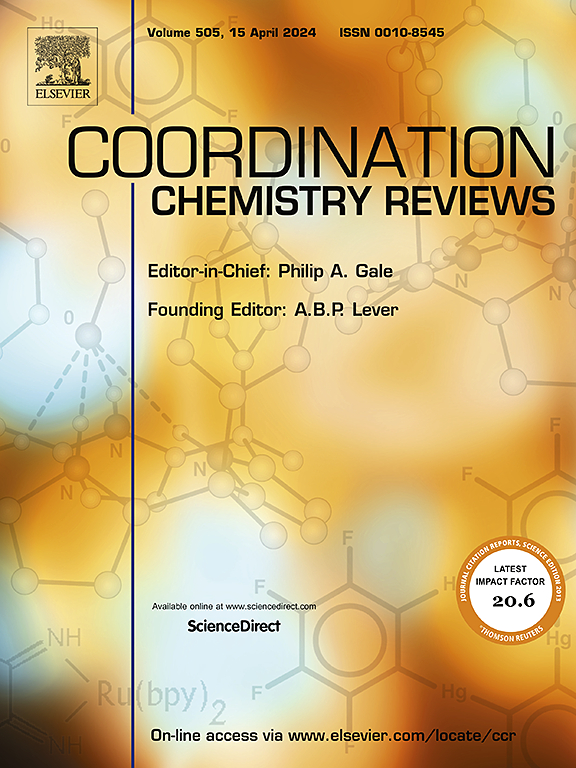Bimetallic covalent-organic frameworks (BMCOFs): Fundamentals and applications
IF 20.3
1区 化学
Q1 CHEMISTRY, INORGANIC & NUCLEAR
引用次数: 0
Abstract
Bimetallic covalent-organic frameworks (BMCOFs) have emerged as a highly promising and versatile class of materials with exceptional catalytic properties and a wide range of applications. BMCOFs act as a bridge between metal-organic frameworks (MOFs) and covalent-organic frameworks (COFs), harnessing the unique properties and characteristics of both materials, resulting in maximum catalytic efficiency and the incorporation of advantageous features. The integration of two different metal species within the COF structure gives rise to a synergistic effect, leading to significantly enhanced catalytic performance when compared to monometallic counterparts.The synthesis of bimetallic COFs involves the meticulous incorporation of two different metal species into the COF, enabling precise control over composition and arrangement. This deliberate manipulation allows for the modulation of catalytic properties, fine-tuning the materials to suit specific applications. The interaction between the two metals and the COF backbone generates a synergistic effect where the combined properties of the metals and the COF structure surpass the capabilities of the individual components. This crucial synergistic effect plays a paramount role in unlocking the enhanced catalytic performance observed in BMCOFs.The unique electronic and geometric characteristics of the two metal species within bimetallic COFs facilitate cooperative interactions with the COF structure, enabling efficient charge transfer, electron delocalization, and improved catalytic activity. The presence of two metals in bimetallic COFs offers exciting opportunities for optimized electronic structures, adjustable redox potentials, and an increased number of active sites. These factors contribute to enhanced catalytic activity, selectivity, and stability, rendering BMCOFs highly desirable for various catalytic processes. Furthermore, the presence of multiple metals within the COF structure provides a rich and diverse landscape of catalytic sites, enabling efficient catalysis of complex chemical reactions.Overall, this paper explores the fundamental aspects of bimetallic COFs and highlights their significant potential in catalysis, showcasing their exceptional performance, unique characteristics, and diverse applications within the field.求助全文
约1分钟内获得全文
求助全文
来源期刊

Coordination Chemistry Reviews
化学-无机化学与核化学
CiteScore
34.30
自引率
5.30%
发文量
457
审稿时长
54 days
期刊介绍:
Coordination Chemistry Reviews offers rapid publication of review articles on current and significant topics in coordination chemistry, encompassing organometallic, supramolecular, theoretical, and bioinorganic chemistry. It also covers catalysis, materials chemistry, and metal-organic frameworks from a coordination chemistry perspective. Reviews summarize recent developments or discuss specific techniques, welcoming contributions from both established and emerging researchers.
The journal releases special issues on timely subjects, including those featuring contributions from specific regions or conferences. Occasional full-length book articles are also featured. Additionally, special volumes cover annual reviews of main group chemistry, transition metal group chemistry, and organometallic chemistry. These comprehensive reviews are vital resources for those engaged in coordination chemistry, further establishing Coordination Chemistry Reviews as a hub for insightful surveys in inorganic and physical inorganic chemistry.
 求助内容:
求助内容: 应助结果提醒方式:
应助结果提醒方式:


